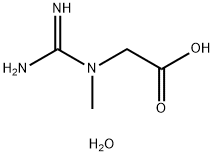Structural Formula

| Name | Creatine Monohydrate |
| Synonyms | N-GUANYL-N-METHYLGLYCINE;N-GUANYL-N-METHYLGLYCINE,MONOHYDRATE;N-METHYL-N-GUANYLGLYCINEMONOHYDRATE;N-AMIDINOSARCOSINE;N-AMIDINOSA ChemicalbookRCOSINEHYDRATE; Glycine,N-(aminoiminomethyl)-N-methyl -, monohydrate; jisuanyisui |
| CAS No. | 6020-87-7 |
| Molecular Formula | C4H11N3O3 |
| Molecular Weight | 149.15 |
| EINECS No. | 611-954-8 |
| Melting point | 292°C(dec.)(lit.) |
| RTECS No. | MB7706000 |
| Storage Conditions | 2-8°C |
| Solubility | slightly soluble inwa Chemicalbookter,insolubleinethanolandether. |
| Form | Crystalline Powder |
| Color | White to yellow |

Uses: artificially synthesized creatine can be used as a nutritional supplement to promote skeletal muscle to adapt to strenuous exercise and combat fatigue in weak individuals; it can also be used to prepare drugs for treating heart disease and respiratory insufficiency; prepare pharmaceutical preparations containing human growth hormone; It can also be used to compound a new health food, which has the effects of anti-aging and restoring youth. Since creatine is not a hormone, it will not cause any interference or damage to the endocrine system of the human body, and will not cause drug dependence or physiological side effects, so creatine supplements have become very popular in recent years. Creatine exists in fish and meat foods, but the amount is very small. It is difficult to obtain all of it from food in order to achieve the daily intake per person that is helpful for growing muscles. Numerous studies have reported that supplementation with creatine monohydrate increases creatine content in skeletal muscle. Creatine can be converted into phosphocreatine under the action of creatine kinase, thereby increasing the energy-supply metabolic pool of phosphocreatine. Supplementary feeding of creatine monohydrate may cause changes in creatine metabolism, which may change the original growth and meat quality of the body. Although there are not many reports on the application of creatine in livestock and poultry production, and the results are quite different, it provides a new and effective method for improving the quality of livestock and poultry meat, showing great application potential.
